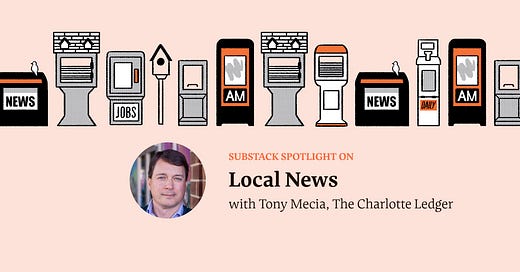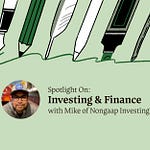Last week, we hosted a workshop with Tony Mecia of The Charlotte Ledger to discuss covering local news on Substack.
Tony worked in journalism as the business reporter and editor with the Charlotte Observer before he decided to strike it out on his own. He started The Charlotte Ledger and grew it the old-fashioned way, building relationships locally and relying on word-of-mouth from friends. Today, The Charlotte Ledger is a thriving business with a team of freelancers and regular contributors.
Writers like Tony have paved the way for independent local news on Substack. In our workshop, we brought together the greater community of local news writers to learn from Tony’s experience and absorb best practices for local news publishing on Substack.
Hamish McKenzie, the co-founder of Substack and a writer himself, hosted the interview with Tony and discussed his journey publishing, growing, and going paid. At the end of this post, we also share Tony’s quick tips for polishing your newsletter.
The interview has been edited for length. You can listen to the full interview as a podcast in this post.
To sign up for future writer interviews and workshops, head here.
Why do you care so deeply about local news?
My background is in local news. I worked as an editor and reporter here in Charlotte for more than 10 years. I saw the connections that you can make here reporting, and how important it is to have somebody in your local community who is watching out for citizens, not paid for by marketing or advertising, and who can actually report honestly and straightforwardly. We've lost that, especially in smaller to mid-sized markets like Charlotte.
As local news in Charlotte weakened, I started looking at my options. I wasn’t going to move somewhere else. I don't want to move to Washington or New York for a job in journalism. I've lived here for more than 20 years. My home is in Charlotte and I care about Charlotte. So I thought, well, maybe I can start something.
At this time, there were a lot of national newsletters – Morning Brew, The Hustle – but there weren't a whole lot of folks using the newsletter format as a vehicle to report original local news.
Tell me about the moment you decided to go independent. What were you most nervous about?
The difference between writing nationally and locally is that your potential audience is a lot smaller when local. If I'm writing about cybersecurity or technology or national politics, the whole country may read that. Charlotte's a city of about 900,000 people in a county of 1.1 million in a region of 2.3 million. But I just thought, let’s try it.
I started in March of 2019. The first editions went to 12 friends and family members. My mom was very happy to get it. I posted it on Twitter, Facebook, and LinkedIn, since our focus is business-adjacent news in Charlotte. I asked that folks read, and if they liked the writing, that they please tell people about it. I had no idea what was going to happen.
What I found was the readership just kept growing. The total list is just a very steady upward line. That made me think, okay, I've got something here. We were publishing three mornings a week, and it was all free at that point.

How did it feel making the leap to paying subscribers?
The Charlotte Ledger was free for almost an entire year. The typical advice from Substack is to wait three months, or less in some cases, before going paid. But I was nervous that our growth would slow down once because we'd be putting a lot of writing out for paid subscribers that would no longer be shareable.
That actually hasn't been true. That first day when we turned on the paid subscriptions, I expected that a handful of people would sign up, but money just started pouring in. It was a few thousand dollars, and I thought, wow, this actually resonates with people. People are willing to pay for this.
It was a tremendous feeling. It wasn’t as if it was so much money that I could retire, but it was a good feeling to know that what you're producing is worth something to somebody.

If I had to do it over again, we probably wouldn’t have waited an entire year before turning on paid subscriptions. That hesitancy was just because of my nervousness. Waiting a year, with no income, with no revenue coming in is a long time. It worked out – my wife works, and we had some severance from a previous job and all that – but in hindsight, we should have turned on paid a little faster.
Why did you decide to cover business news rather than just local news in Charlotte?
I'm not opposed to doing local news, and we do a fair amount of general news, but our theory has always been that we want to do writing that's better than what's already in Charlotte, and we want to do writing that's different than what's already in Charlotte.
The number of business reporters here in Charlotte had declined, and I saw an opening content-wise. My background was in business news. It’s something that I knew and felt comfortable covering. There's a pretty big market for it in Charlotte. We’re a business town with banks and tech companies. It's a pretty big city. Business writing also has the advantage that if the newsletter is useful to an employee, they can charge the subscription cost to their company as a business expense.
What wisdom can you pass on to other local news writers who are considering Substack?
Two things. First, it's hard for journalists whose background is in reporting a story to all of a sudden have to think like a business person. But you need to think about your audience. There's a temptation with local journalism to think, “I'm writing about Charlotte, so anybody in Charlotte is going to be interested in it.” To succeed, you’ll need to hone that down a little bit more.
Ask: Who are you trying to appeal to? And how will you find them? You need to think strategically about who the people are who are most likely to read your work, then determine where they hang out physically or online and how you could reach them where they are. Use your marketing or business brain on those strategy questions.
Second, you're not alone. I've gotten a lot of good advice from fellow local news writers – City Hall Watcher in Toronto, The Mill in England. I'm not saying that we've got all the answers, but we've done this for longer than most people in the local news space on Substack. Steal good ideas from other people.
Tony’s quick tips for local news writers
Don’t overthink your paid vs. free strategy. The Charlotte Ledger has days of the week where their posts are free. Their “paid days” are Wednesdays and Fridays. On occasion, they cover free topics that may be outside their publication scope because the team believes they may be shareable.
Let free readers know what they are missing. For every paid post, The Charlotte Ledger sends out a shorter “teaser” version to their free subscribers. If free subscribers want to read the rest, they need to subscribe. Because of this tactic, The Charlotte Ledger sees new subscriptions even on “paid days.”
Include guidance about subscribing at the top of every email. “Although we don’t want to be ‘annoying,’ we do have to think like a business.”
To promote locally, consider partnerships. There are no magic growth hacks with local news. Instead, you’ll need to do a lot of little promotions consistently. Partner with a variety of people in your community to get in front of different groups. Tony has partnered with Charlotte’s local radio station, local Facebook Groups, and even hosted an awards show to ensure members of his community bump into The Charlotte Ledger.
10,000 readers is a useful benchmark. If you believe you can build a list of 10,000 free readers, you have a strong chance of converting 10% (1,000) of those people into paid subscribers. That’s enough to support a livelihood.
Hoping for more tips on how to start a local news publication on Substack? Check out our comprehensive playbook here.
Spotlight On is a series of live events hosted by Substack. The goal is to learn from writers across categories who have experienced success on Substack. Join us for our next Spotlight On: Fiction with Elle Griffin.













Share this post